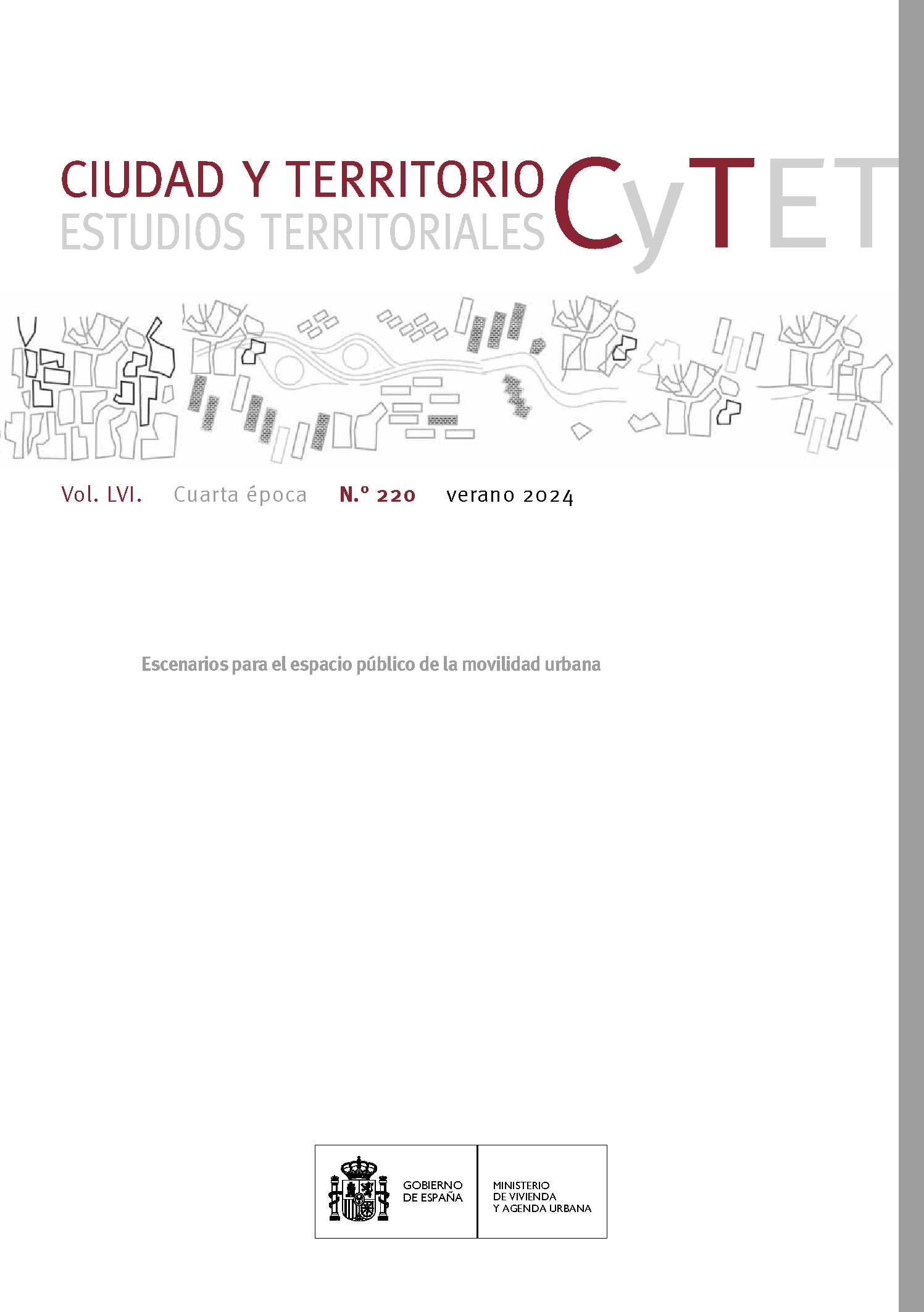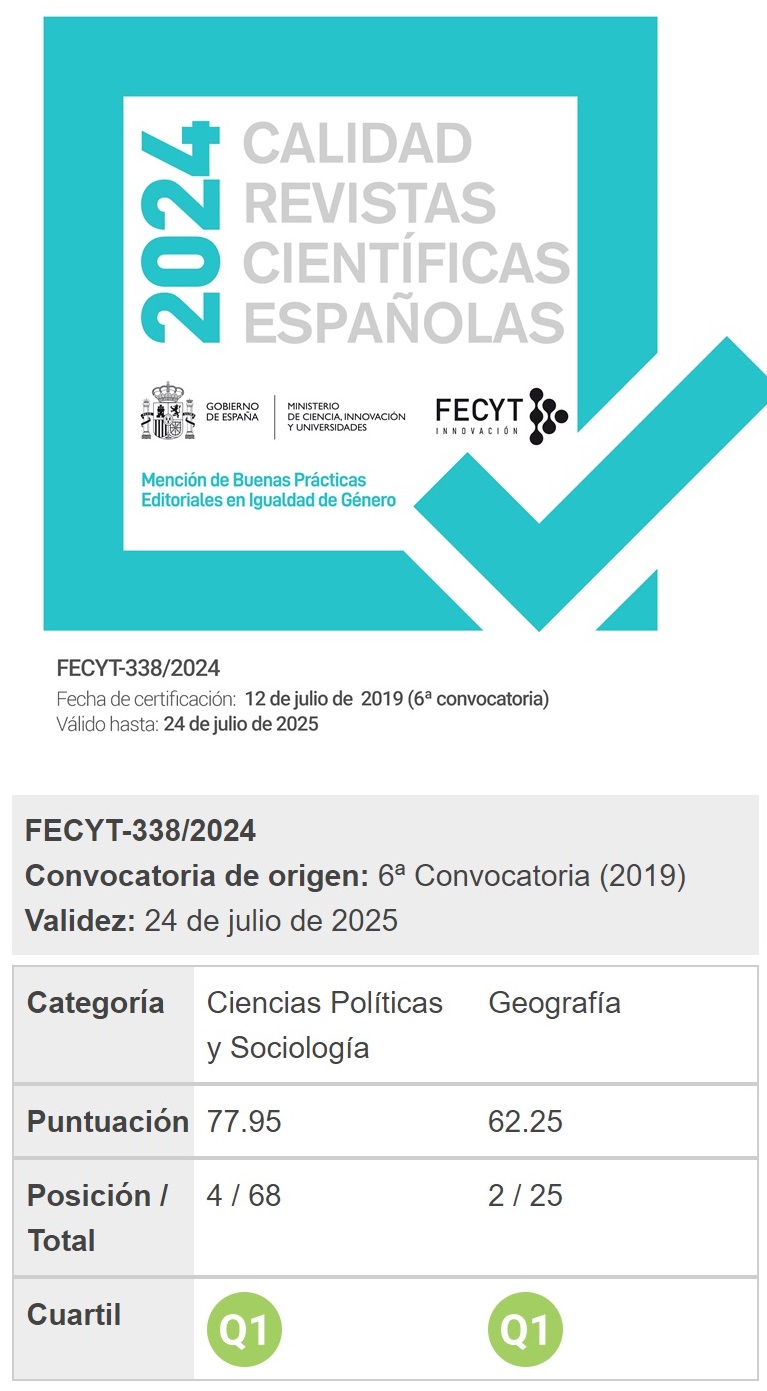Diseñando la Ciudad de los 15 minutos a escala calle: un análisis bottom-up de la proximidad social
DOI:
https://doi.org/10.37230/CyTET.2024.220.1Palabras clave:
Ciudad de los 15 minutos, Proximidad, Diseño de calle, Interacción social en espacio público, Nuevo urbanismoResumen
La Ciudad de los 15 minutos se basa en la Densidad, Proximidad, Diversidad y Digitalización. La proximidad, espacial y temporal, se relaciona estrechamente con la interacción social y vitalidad. Este artículo examina con un enfoque bottom-up empleando una metodología multi-método y a través de 4 calles de Madrid, los factores que más influyen en la interacción social en la calle y su conexión con la proximidad social del modelo. Se pretende que los resultados orienten el diseño de calles alineadas con el concepto de los 15 minutos, es decir, vibrantes y propicias para la interacción social. Factores como la disposición espacial de la calle, la presencia de mobiliario urbano y la oferta de servicios y actividades son crucialmente relevantes. Aunque las calles de Madrid pueden albergar el modelo de Moreno en términos de proximidad social, se identifican algunas deficiencias.
Descargas
Citas
ALLAM, Z. & BIBRI, S. E. & CHABAUD, D. & MORENO, C. (2022a): The Theoretical, Practical, and Technological Foundations of the 15-Minute City Model: Proximity and Its Environmental, Social and Economic Benefits for Sustainability. Energies, 15(16), pp. 1–20. https://doi.org/10.3390/en15166042
ALLAM, Z. & BIBRI, S. E. & CHABAUD, D. & MORENO, C. (2022b): The ‘15-Minute City’ concept can shape a net-zero urban future.Humanities and Social Sciences Communications, 9, 126. Springer Nature. https://doi.org/10.1057/s41599-022-01145-0
APPLEYARD, D. (1981): Liveable streets, Berkeley, Estados Unidos,University of California Press
APPLEYARD, D. & JACOBS, A. (1987): Toward an Urban Design Manifesto. Journal of the American Planning Association, 53:1, pp. 112-120. DOI: https://www.tandfonline.com/doi/abs/10.1080/01944368708976642
BILD, E. & COLER, M. & PFEFFER, K. & BERTOLINI, L. (2016): Considering Sound in Planning and Designing Public Spaces: A Review of Theory and Applications and a Proposed Framework for Integrating Research and Practice. Journal of Planning Literature, 31(4), pp. 419–434. https://doi.org/10.1177/0885412216662001
BROWN, S. & LOMBARD, J. (2014): Neighborhoods and Social Interaction. Wellbeing: A Complete Reference Guide, Volume II., Edition: Volume II, Chapter: Neighborhoods and social interaction., John Wiley & Sons, Ltd., Editors: R. Cooper, E. Burton, C. L. Cooper, pp.91-118. https://doi.org/10.1002/9781118539415.wbwell059
CARPIO-PINEDO, J. (2020a): Formas urbanas para la interacción social en la metrópolis de la movilidad: Madrid. A: Llop, C.; Cervera, M.; Peremiquel, F. (eds.). "IV Congreso ISUF-H: Metrópolis en recomposición: prospectivas proyectuales en el Siglo XXI: Forma urbis y territorios metropolitanos, Barcelona, 28-30 Septiembre 2020" pp. 1-18. Barcelona: DUOT, UPC, ISBN 978-84-9880-841-4.
CARPIO-PINEDO, J. (2020b): Spaces for consumption in the mobile metropolis: symbolic capital, multi-accessibility amd spatial conditions for social interaction. [Tesis doctoral, Universidad Politécnica de Madrid] https://oa.upm.es/65613/1/JOSE_CARPIO_PINEDO.pdf
CLARIS, S. & SCOPELLITI, D. (2016): Cities Alive: Towards a Walking World. Londres, Reino Unido, ARUP. Disponible online: https://www.arup.com/-/media/arup/files/publications/c/cities-alive_towards-a-walking-world_lowres.pdf [17/01/2024].
DA SILVA, D. C. & KING, D. A. & LEMAR, S. (2020): Accessibility in practice: 20-minute city as a sustainability planning goal. Sustainability (Switzerland), 12(1). https://doi.org/10.3390/SU12010129
DELCLÒS-ALIÓ, X. & MIRALLES-GUASCH, C. (2018): Looking at Barcelona through Jane Jacobs’s eyes: Mapping the basic conditions for urban vitality in a Mediterranean conurbation. Land Use Policy, 75, pp. 505-517. ISSN 0264-8377, https://doi.org/10.1016/j.landusepol.2018.04.026
ECHEVARRIA SANCHEZ, G. M. & VAN RENTERGHEM, T. & SUN, K. & DE COENSEL, B. & BOTTELDOOREN, D. (2017): Using Virtual Reality for assessing the role of noise in the audio-visual design of an urban public space. Landscape and Urban Planning, 167(June), 98–107. https://doi.org/10.1016/j.landurbplan.2017.05.018
EZQUIAGA-DOMÍNGUEZ, J.M. (2002): Madrid: las formas de la nueva centralidad. Revista Nacional de Arquitectura, 329, pp. 60-69.
GEHL, J. (2010): Cities for people. Washington, DC, Estados Unidos, Island Press
GEHL, J. (2011): Life between buildings (6th ed.). Washington D.C., Estados Unidos, Island Press.
GEHL, J. & SVARRE, B. (2013): Jan Gehl & Birgitte Svarre. How to Study Public Life. Washington D.C., Estados Unidos, Island Press https://tudelft.on.worldcat.org/oclc/865475474
GÖSSLING, S. (2020): Why cities need to take road space from cars - and how this could be done. Journal of Urban Design, 25(4), 443–448. https://doi.org/10.1080/13574809.2020.1727318
GRANOVETTER, M. (1973): “The strength of weak ties”. The American Journal of Sociology. 78, pp. 1360-1380.
GRUEBNER, O. & RAPP, M. A. & ADLI, M. & KLUGE, U. & GALEA, S. & HEINZ, A. (2017): Cities and mental health. Deutsches Arzteblatt International, 114(8), 121–127. https://doi.org/10.3238/arztebl.2017.0121
GWIAZDZINSKI, L. (2014): The Malleable, Adaptable Metropolis: Toward a Temporary and Temporal Urbanism. Stream-03/Inhabting the Anthropocene, pp.51-61. ISBN 978-2-9540-9693-3
HANDY, S.L. & BOARNET, M.G. & EWING, R. & KILLINGSWORTH, R.E. (2002): How the Built Environment Affects Physical Activity: Views from Urban Planning. American Journal of Preventive Medicine, 23, pp. 64–73.
JACOBS, J. (1992): The life and Death of Great American Cities. Nueva York, Estados Unidos, Vintage
KIM, S. & CHOI, J. & KIM, Y. (2011): Determining the Sidewalk Pavement Width by Using Pedestrian Discomfort Levels and Movement Characteristics. Tranportation Engineering, 15(5), pp. 883-889. https://doi.org/10.1007/s12205-011-1173-1
LINK, F. & SEÑORET, A. & VALENZUELA, F. (2022): From Community to Public Familiarity: Neighborhood, Sociability, and Belonging in the Neoliberal City. Urban Affairs Review, 58(4), 960–995. https://doi.org/10.1177/10780874211021512
LÓPEZ DE LUCIO, R. (2003): Transformaciones territoriales recientes en la región urbana de Madrid. Urban, 8, pp 124-161.
LÓPEZ-LAMBAS, M.E. & SÁNCHEZ, J.M. & ALONSO, A. (2019): The Walking Health: A Route Choice Model to Analyze the Street Factors Enhancing Active Mobility. Journal of Transport Health, 22, 101133. https://doi.org/10.1016/j.jth.2021.101133
MAGHELAL, P. K. & CAPP, C. J. (2011): Walkability: A review of existing pedestrian indices. URISA Journal, 23(2), 5–19.
MARQUET, O. & MIRALLES-GUASCH, C. (2015): The Walkable city and the importance of the proximity environments for Barcelona’s everyday mobility. Cities, 42, pp. 258-266. https://doi.org/10.1016/j.cities.2014.10.012
MEHTA, V. (2007): Lively Streets Determining Environmental Characteristics To Support Social Behavior. Journal of Planning Education and Research, 2, pp. 165-187. DOI: https://doi.org/10.1177/0739456X07307947
MEHTA, V. & BOSSON, J. K. (2010): Third places and the social life of streets. Environment and Behavior, 42(6), pp. 779–805. https://doi.org/10.1177/0013916509344677
MEHTA, V. & BOSSON, J. K. (2018): Revisiting Lively Streets: Social Interactions in Public Space. Journal of Planning Education and Research, 41(2), 160-172. https://doi.org/10.1177/0739456X18781453
MINISTERIO DE TRANSPORTES, MOVILIDAD Y AGENDA URBANA. (2020): Sistema de indicadores y condicionantes para ciudades grandes y medianas.
MOAYEDI, F. & ZAKARIA, R. & BIGAH, Y. & MUSTAFAR, M. & PUAN, O. C. & ZIN, I. S. & KLUFALLAH, M. M. A. (2013): Conceptualising the indicators of walkability for sustainable transportation. Jurnal Teknologi (Sciences and Engineering), 65(3), pp. 85–90. https://doi.org/10.11113/jt.v65.2151
MORENO, C. & ALLAM, Z. & CHABAUD, D. & GALL, C. & PRATLONG, F. (2021): Introducing the “15-Minute City”: Sustainability, Resilience and Place Identity in Future Post-Pandemic Cities. Smart Cities, 4, pp. 93-111. https://doi.org/10.3390/smartcities4010006
MORENO, C. & GALL, C. & CHABAUD, D. & GARNIER, M. & MASSONILLIAN, I. & PRATLONG, F. (2023): The 15-minute City model: An innovative approach to measuring the quality of life in urban settings 30-minute territory model in low-density areas WHITE PAPER N°3. IAE Paris-Université Paris 1 Panthéon Sorbonne.
MORRISSEY, L. (2020): The Connection between People and Place: A Case Study on Social Interactions in UA Outdoor Public Spaces.Disponible online: https://repository.arizona.edu/bitstream/handle/10150/641186/Morrissey_CapstonePaper_Upload.pdf?sequence=5&isAllowed=y [16/01/2024]
MOURATIDIS K. & POORTINGA, W. (2020): Built environment,urban vitality and social cohesion: Do vibrant neighborhoods foster strong communities?. Lanscape and Urban Planning, 204, 103951 https://doi.org/10.1016/j.landurbplan.2020.103951
NELLO-DEAKIN, S. (2019): Is there such a thing as a ‘fair’ distribution of road space? Journal of Urban Design, 24(5), pp. 698–714. https://doi.org/10.1080/13574809.2019.1592664
OLDENBURG, R. & BRISSETT, D. (1982): The third place. Qualitative Sociology, 5(4), 265–284. https://doi.org/10.1007/BF00986754
POZOUKIDOU, G. & CHATZIYIANNAKI, Z. (2021): 15‐minute city: Decomposing the new urban planning Eutopia. Sustainability (Switzerland), 13(2), pp. 1–25. https://doi.org/10.3390/su13020928
POZUETA, J. & F.J. LAMÍQUIZ & PORTO, M. (2009): La Ciudad Paseable: Recomendaciones Para la Consideración de los Peatones en el Planeamiento, el Diseño Urbano y la Arquitectura. Madrid, España. CEDEX.
PUTNAM, R. (2001): Bowling Alone: The Collapse and Revival of American Community. Nueva York, Estados Unidos, Simon and Schuster
RAHMAN, N. A. & SHAMSUDDIN, S. & GHANI, I. (2015): What Makes People Use the Street?: Towards a Liveable Urban Environment in Kuala Lumpur City Centre. Procedia - Social and Behavioral Sciences, 170, pp. 624–632. https://doi.org/10.1016/j.sbspro.2015.01.064
RANGEL MORA, M, (2009): Indicadores de calidad de los espacios públicos urbanos para la vida ciudadana en ciudades intermedias. En Carme Bellet Sanfeliu y Maria Encarnação Beltrão Sposito (coords.), Las ciudades medias o intermedias en un mundo globalizado. (pp. 317-340). Lleida: Universitat de Lleida.
RUEDA, S. (2010): Plan De Indicadores De Sostenibilidad Urbana de Vitoria-Gasteiz. Disponible online: https://www.vitoria-gasteiz.org/docs/wb021/contenidosEstaticos/adjuntos/es/89/14/38914.pdf [18/01/2024]
SAELENS, B.E., HANDY, S.L. (2008): Built environment correlates of walking: a review. Med. Sci. Sport. Exer. 40 (7), pp.550–566.
SALAZAR MIRANDA, A. & FAN, Z. & DUARTE, F. & RATTI, C. (2021): Desirable streets: Using deviations in pedestrian trajectories to measure the value of the built environment. Computers, Environment and Urban Systems, 86, 101563, ISSN 0198-9715, https://doi.org/10.1016/j.compenvurbsys.2020.101563
SÁNCHEZ-DE MADARIAGA, I. & ZUCCHINI, E. (2020): “Movilidad del cuidado” en Madrid: nuevos criterios para las políticas de transporte. Ciudad Y Territorio Estudios Territoriales, 52(203), 89–102. https://doi.org/10.37230/CyTET.2020.203.08
SOLÍS, E. (2021): A pie o en bici. Forma urbana. En B. RUIZ-APILÁNEZ y E. SOLÍS (Eds.) A pie o en bici. Perspectivas y experiencias en torno a la movilidad activa, (pp. 51-59). Eds, Universidad de Castilla-La Mancha. http://doi.org/10.18239/atenea_2021.25.00
SPECK, J. (2018): Walkable city rules:101 steps to making better places, Washington DC, Estados Unidos, Island Press.
TALAVERA-GARCÍA, R. & SORIA-LARA, J.A. (2015): Q-PLOS, developing an alternative walking index. A method based on urban design quality. Cities, 45, pp.7-17. https://doi.org/10.1016/j.cities.2015.03.003
WENG, M. & DING, N. & LI, J. &, JIN, X. & XIAO, H. & HE, Z. & SU, S. (2019): The 15-minute walkable neighborhoods: Measurement, social inequalities and implications for building healthy communities in urban China. Journal of Transport & Health, 13, pp. 259-273, ISSN 2214-1405, https://doi.org/10.1016/j.jth.2019.05.005
WHYTE, W. (1980): The Social Life of Small Urban Spaces, Nueva York, Estados Unidos, Project for Public Spaces
Publicado
Cómo citar
Número
Sección
Licencia
Derechos de autor 2024 Mari Luz Brownrigg Gleeson, Andrés Monzón, Andrea Alonso

Esta obra está bajo una licencia internacional Creative Commons Atribución-NoComercial-SinDerivadas 4.0.
Sin perjuicio de lo dispuesto en la legislación vigente sobre Propiedad Intelectual, y conforme a la misma, el/la los/las autor/a/es/as que publiquen en CyTET cede/n a título gratuito, de modo no exclusivo y sin límite temporal al Ministerio de Transportes, Movilidad y Agenda Urbana los derechos para difundir, reproducir, comunicar y distribuir en cualquier formato actual o futuro, en papel o electrónico, la versión original o derivada de su obra bajo licencia de Creative Commons Reconocimiento-NoComercial-SinObraDerivada 4.0 Internacional (CC BY-NC-ND 4.0), así como para incluir o ceder a terceros la inclusión de su contenido en índices, repositorios y bases de datos nacionales e internacionales, con referencia y reconocimiento en todo caso de la autoría del mismo.
Además, al realizar el envío, el/la los/las autor/a/es/as declara/n que se trata de un trabajo original en el que se reconocen las fuentes que han sido utilizadas en su estudio, comprometiéndose a respetar la evidencia científica y a no modificar los datos originales para verificar o refutar una hipótesis de partida; que el contenido esencial del mismo no ha sido publicado previamente ni se publicará en ninguna otra obra o revista mientras esté en proceso de evaluación en la revista CyTET; y que no se ha remitido simultáneamente a otra publicación.
Los autores deben firmar un Formulario de Cesión de Derechos, que les será enviado desde la Secretaría de CyTET una vez se acepte su artículo para ser publicado.
Con el objetivo de favorecer la difusión del conocimiento, CyTET se adhiere al movimiento de revistas de Open Access (OA) y entrega la totalidad de sus contenidos a diversos índices, repositorios y bases de datos nacionales e internacionales bajo este protocolo; por tanto, la remisión de un trabajo para ser publicado en la revista presupone la aceptación explícita por parte del autor/a de este método de distribución.
Se anima a las/os autoras/es a reproducir y alojar sus trabajos publicados en CyTET en repositorios institucionales, páginas web, etc. con la intención de contribuir a la mejora de la transferencia del conocimiento y de la citación de dichos trabajos.








 Enlace a CyTET en Linkedin
Enlace a CyTET en Linkedin